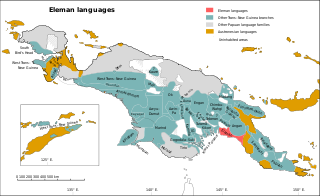
The Papuan languages are the non-Austronesian and non-Australian languages spoken on the western Pacific island of New Guinea, and neighbouring islands, by around 4 million people. It is a strictly geographical grouping, and does not imply a genetic relationship. The concept of Papuan peoples as distinct from Austronesian-speaking Melanesians was first suggested and named by Sidney Herbert Ray in 1892.
The Sko or Skou languages are a small language family spoken by about 7000 people, mainly along the Vanimo coast of Sandaun Province in Papua New Guinea, with a few being inland from this area and at least one just across the border in the Indonesian province of Papua.

The West Papuan languages are a proposed language family of about two dozen non-Austronesian languages of the Bird's Head Peninsula of far western New Guinea, the island of Halmahera and its vicinity, spoken by about 220,000 people in all. It is not established if they constitute a proper linguistic family or an areal network of genetically unrelated families.

The Mantion–Meax or (South)East Bird's Head languages are a language family of three languages in the "Bird's Head Peninsula" of western New Guinea, spoken by all together 20,000 people.

The Mairasi languages, also known as Etna Bay are a small independent family of Papuan languages in the classifications of Malcolm Ross and Timothy Usher, that had been part of Stephen Wurm's Trans–New Guinea proposal. They are named after Etna Bay, located in the southeastern corner of West Papua province, in Indonesia.
The Yuat languages are an independent family of five Papuan languages spoken along the Yuat River in East Sepik Province, Papua New Guinea. They are an independent family in the classification of Malcolm Ross, but are included in Stephen Wurm's Sepik–Ramu proposal. However, Foley and Ross could find no lexical or morphological evidence that they are related to the Sepik or Ramu languages.
Elseng is a poorly documented Papuan language spoken by about 300 people in the Indonesian province of Papua. It is also known as Morwap, which means "what is it?" ‘Morwap’ is vigorously rejected as a language name by speakers and government officials.

The Kiwaian languages form a language family of New Guinea. They are a dialect cluster of half a dozen closely related languages. They are grammatically divergent from the Trans–New Guinea languages, and typically have singular, dual, trial, and plural pronouns.
The Pauwasi languages are a likely family of Papuan languages, mostly in Indonesia. The subfamilies are at best only distantly related. The best described Pauwasi language is Karkar, across the border in Papua New Guinea. They are spoken around the headwaters of the Pauwasi River in the Indonesian-PNG border region.

The Eleman languages are a family spoken around Kerema Bay, Papua New Guinea.

The Duna–Pogaya (Duna–Bogaia) languages are a proposed small family of Trans–New Guinea languages in the classification of Voorhoeve (1975), Ross (2005) and Usher (2018), consisting of two languages, Duna and Bogaya, which in turn form a branch of the larger Trans–New Guinea family. Glottolog, which is based largely on Usher, however finds the connections between the two languages to be tenuous, and the connection to TNG unconvincing.

The Lower Sepik a.k.a. Nor–Pondo languages are a small language family of East Sepik Province in northern Papua New Guinea. They were identified as a family by K Laumann in 1951 under the name Nor–Pondo, and included in Donald Laycock's now-defunct 1973 Sepik–Ramu family.

The Sepik Hill languages form the largest and most ramified branch of the Sepik languages of northern Papua New Guinea. They are spoken along the southern margin of the Sepik floodplain in the foothills of Central Range of south-central East Sepik Province.
Pyu is a language isolate spoken in Papua New Guinea. As of 2000, the language had about 100 speakers. It is spoken in Biake No. 2 village of Biake ward, Green River Rural LLG in Sandaun Province.
Abun, also known as Yimbun, Anden, Manif, or Karon, is a Papuan language spoken by the Abun people along the northern coast of the Bird's Head Peninsula in Sausapor District, Tambrauw Regency. It is not closely related to any other language, and though Ross (2005) assigned it to the West Papuan family, based on similarities in pronouns, Palmer (2018), Ethnologue, and Glottolog list it as a language isolate.

Morori is a moribund Papuan language of the Kolopom branch of the Trans–New Guinea family. It is separated from the other Kolopom languages by the intrusive Marind family. All speakers use Papuan Malay or Indonesian as L2, and many know Marind.

Mor is a nearly extinct Trans–New Guinea language of Indonesia. It is spoken along the Budidi River and the Bomberai River on the Bomberai Peninsula.

Sumuri or Sumeri is a language spoken in Sumuri District, Teluk Bintuni Regency on the Bomberai Peninsula by about a thousand people.

Pawaia, also known as Sira, Tudahwe, Yasa, is a Papuan language that forms a tentative independent branch of the Trans–New Guinea family in the classification of Malcolm Ross (2005).
Yetfa and Biksi are dialects of a language spoken in Jetfa District, Papua, Indonesia, and across the border in Papua New Guinea. It is a trade language spoken in West Papua up to the PNG border.














